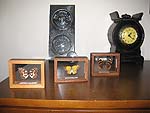After some time, I decided that they are the most beautiful creature in Nature, and I began collecting them, I learned how to behave with them, preserve them in a triangular paper bag and after softening in a wet atmosphere to open their wings, set in proper position and after drying to put them in a frame.
This process is very delicate because they are very sensitive when handled. Nevertheless, my collection has been growing for more than 60 years, and my collection houses more than 1200 different specimens.
During this activity I travelled to many countries and became familiar with the techniques of preservation of butterflies, but I have not found them effective (different protections of infections and small parasites) so I invented a special technique in construction of frames with double glass. This enabled me to preserve butterflies, more than 60 years old!
We can admire these creatures of extraordinary beauty, and it is a sad fact we know practically nothing of their history!
Their blood is cold. They do not have a heart to pump the vital liquid through the body, they use the capillarity phenomenon where the diameter of liquid transport tubes is limited, and thus the biggest body of butterflies can not be greater than our little finger. So it was all the thousand of millenniums in the past.
Every day scientists discover a vast array of creatures that have lived in natures past, but sadly there are no remains of butterflies! They are so fragile that they disappear and disintegrate after death.
The future of butterflies unfortunately, is not a bright one, their purpose in nature is to serve to transport pollen from one flower to the other searching for nectar, their food but fertilisers and different poisons for killing weeds, exterminate them. They disappear from nature or hide deep in woods.
Mankind is one of their worst enemies and there are some others, such as flies and certain species of wasp. One wasp in particular is very dangerous as it injects anaesthetic in the caterpillar, causing paralysis yet leaving them alive while they place eggs in the body of the caterpillar. When the eggs hatch the little wasps grow and feed on the body of the caterpillar.
The caterpillars who are lucky enough to emerge from the egg,
eat large quantities of leafs and after surviving all the dangers
while closed in a stiff envelope – chrysalis or pupae
forms the beginning of their most incredible and wondrous process
of Metamorphosis!
The ugly caterpillar, with many legs and ghastly appearance
to scare the enemies begin to transform into a beautiful butterfly
– one creature with 6 legs, head with eyes, thorax with
muscles and wings and all sensors necessary for flying and searching
for flowers and avoiding dangers. The transformation finished,
the butterflies (“imago”) emerge from the stiff
pupae, stretch their wings, dry them and… fly!!!
The big adventure of the butterfly begins …
 |
 |
 |




 |
||
 |
 |
 |
 |
 |
 |
 |
 |
 |




 |
||
 |
 |
 |
| click on image to enlarge | ||